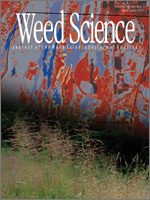Weed seed persistence in soil can be influenced by many factors, including crop management. This research was conducted to determine whether organic management systems with higher organic amendments and soil microbial biomass could reduce weed seed persistence compared with conventional management systems. Seeds of smooth pigweed and common lambsquarters were buried in mesh bags in organic and conventional systems of two long-term experiments, the Farming Systems Project at the Beltsville Agricultural Research Center, Maryland, and the Farming Systems Trial at the Rodale Institute, Pennsylvania. Seed viability was determined after retrieval at half-year intervals for 2 yr. Total soil microbial biomass, as measured by phospholipid fatty acid (PLFA) content, was higher in organic systems than in conventional systems at both locations. Over all systems, locations, and experiments, viable seed half-life was relatively consistent with a mean of 1.3 and 1.1 yr and a standard deviation of 0.5 and 0.3 for smooth pigweed and common lambsquarters, respectively. Differences between systems were small and relatively inconsistent. Half-life of smooth pigweed seeds was shorter in the organic than in the conventional system in two of four location-experiments. Half-life of common lambsquarters was shorter in the organic than in the conventional system in one of four location-experiments, but longer in the organic than in the conventional system in two of four location-experiments. There were few correlations between PLFA biomarkers and seed half-lives in three of four location-experiments; however, there were negative correlations up to −0.64 for common lambsquarters and −0.55 for smooth pigweed in the second Rodale experiment. The lack of consistent system effects on seed persistence and the lack of consistent associations between soil microbial biomass and weed seed persistence suggest that soil microorganisms do not have a dominating role in seed mortality. More precise research targeted to identifying specific microbial functions causing seed mortality will be needed to provide a clearer picture of the role of soil microbes in weed seed persistence.
Nomenclature: Common lambsquarters, Chenopodium album L. CHEAL; smooth pigweed, Amaranthus hybridus L. AMACH





